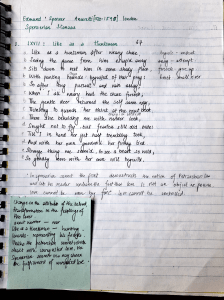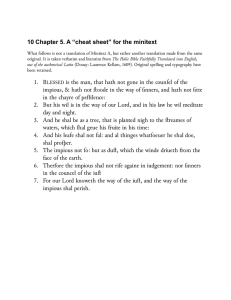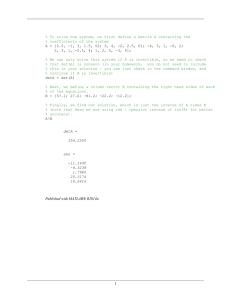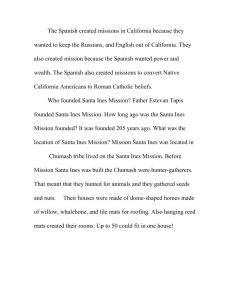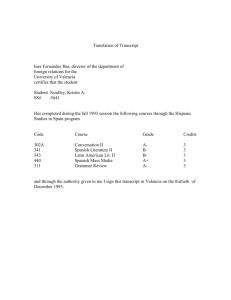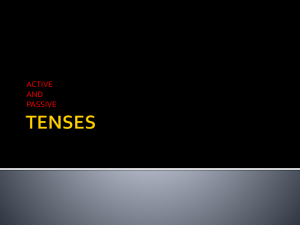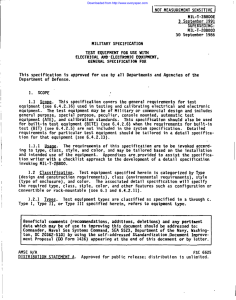WORKINGGROUP V/ PER OLOF FAGERHOLM DrTechn
advertisement
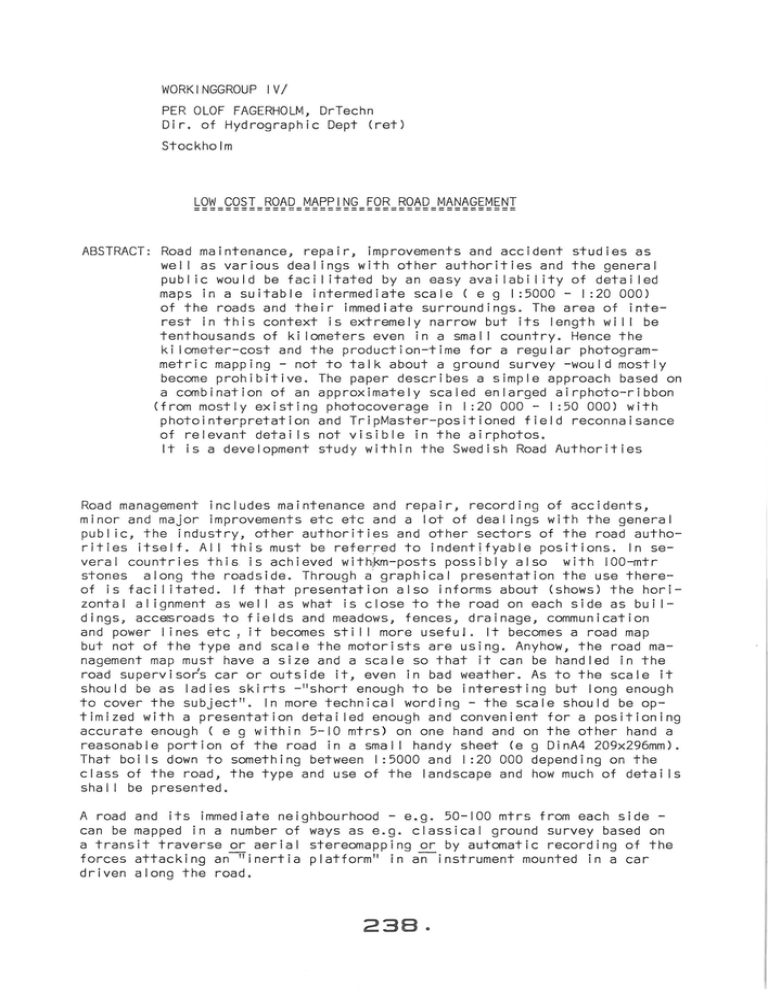
WORKINGGROUP IV/
PER OLOF FAGERHOLM , DrTechn
Di r . of Hydrograph i c Dept (ret )
Stockholm
ABSTRACT : Road ma i ntenance, repai r, improvements and acc i dent stud ies as
we i I as var ious dea li ngs with othe r author ities and the genera l
pub li c would be fac i I itated by an easy ava i labi I ity of deta i led
maps i n a su itable intermediate sca le ( e g I : 5000 - I : 20 000)
of the roads and the i r immed i ate su r round i ngs . The area of i nte rest i n th i s context is ext r emely nar r ow but its length wi I I be
tenthousands of ki lometers even i n a smal I country . Hence the
kilometer - cost and the product i on -ti me for a regu lar photogram metr i c mapp i ng - not to talk about a ground survey - wou l d most ly
become proh i bitive . The paper descr i bes a s imple approach based on
a comb i nat i on of an approxi mately scaled enla r ged airphoto- r i bbon
(from mostly ex i st i ng photocoverage i n I : 20 000 - I : 50 000) with
photo i nterpretat i on and TripMaste r- pos itioned f ield reconnaisance
of relevant deta i Is not v i s ib le in the airphotos .
It is a deve lopment study wit h i n the Swedish Road Authorities
Road management includes maintenance and repa i r , record i ng of acc i dents,
mi nor and majo r improvemen t s etc etc and a lot of dea li ngs with the gene r al
public , the industry , other authorit ies and other sect or s of the road autho r i t i es itself. Al l this must be refer.red to indent i fyable positions . In se ve r a l countries th i s is ach ieved wi th,km-posts poss i bly also with 100 -mtr
stones along the r oads i de . Through a graph ical presentat ion the use the r e of is faci I i tated . If that presentation also informs about (shows) the hori zontal a l ignment as wei I as what i s c lose to the road on each side as bui 1dings , accesroads to f ields and meadows, fences , dr ainage , commun i cat i on
and power l ines etc , it becomes st ill more useful. It becomes a r oad map
but not of the type and sca le the motorists a r e us i ng . Anyhow, the road ma nagement map must have a size and a scale so that it can be hand led i n the
road supe r v i sors car or outs i de it , even in bad weathe r. As to the scale it
shou Id be as Iad i es sk i rts - 11 sho r t enough to be i nterest i ng but Iong enough
to cover the subject 11 • In more techn ical wo r d i ng - the scale should be op tim i zed with a presentation detai led enough and convenient for a pos it ion i ng
accurate enough ( e g with i n 5-1 0 mtrs) on one hand and on the other hand a
r easonable port i on of the road in a sma l I handy sheet (e g Di nA4 209x296mm) .
That boi Is down to something between I : 5000 and I : 20 000 depend i ng on the
c lass of the road , the type and use of the landscape and how much of deta i Is
sha l I be presented .
A road and it s immed iate ne i ghbourhood - e . g . 50- 100 mtrs f r om each side can be mapped i n a numbe r of ways as e . g . c lassical ground survey based on
a transit traverse or ae ri al stereomapp i ng or by automat ic r ecord i ng of the
forces attacking an 11 ine r t ia platform 11 i n an i nstrument mounted i n a car
driven along the road .
238.
The var i ous methods have the i r advantages and disadvantages . For most of them
it is either a matter of high costs or to spa r se an i nformation on the thou sands of deta i Is a long the road which g ive a good p icture of alI the interaa t ions between t he road and the act i vit ies by man and nature a long it . Such
deta i Is also fac i I itate the direct position identif i cation when observing ,
report i ngor issuing orders about something regard i ng the road .
Stereophotogrammetrica l ly plotted maps can inc l ude much of deta il ed informain a more or less digested form , ortophotos the same but i n undigested fo rm,
but those methods become fairly expens i ve as on ly a very narrow str i p of
each stereomode l i s used when plotting the map or producin g the height data
needed for the or tophoto- production .
In road management ope r ations it is no rmally more importa nt and help ~ ul t o
know the relative posi t ions of those po i nts or road po r tions which are invo lved than to know the ir coordinates i n the coord i nate system of the coun try or to know the exact d i stance from a certain reference point wh i ch may
be a road cross i ng severa l kilometers away .
An airphoto i s exce l lent in presenting innumerab le pieces of i nformat i on and
the i r relat i ve positions . But an ord i nary airphoto on which a po r tion of the
road i s depicted together with mi I I i ons of pieces of i nformat i on out s ide the
immediate r oad neigh·bourhood and thus ir r elevant to the road act i v i t ies is
not pr act ical i n an unprocessed form . One reason of seve r al is that the r oad
in an a i rphoto , if not taken particularely for r oad pu r poses , may cut askew
over a corner of the a i rphoto , a second that it is d i ff icult to keep a fa i r
number of a i rphotos in order , a th ir d i s that there are numerous p i eces of
important i nformat i on about the road wh ich are not o r hard l y vis i ble in the
a i rphoto and thus must be ma r ked and a fou r th reason is e g that i t is almost
impossible to make clearly understood notat i ons with the a i rphoto texture
as the wr iting surface .
In some countries , the ground a r ea occupied by the road as we l l as its dra inage system etc . are f r om legal po i nt of view a kind of land holding and
therefor boundary - marked and surveyed with high prec i sion . In other countri es , as in Sweden, the pub I ic i nterest i s secured by "the r i ght of way" and
then it is not a matter of a fo rmal title reg i stration . Anyhow, maps produ ced for t it le registration or for r i ght - of -way formalities are normally of
such a type and i n such an impract ica l large sca le that they are not suitable for a regu lar rout i ne road management .
The same applies common l y to~ he large scale maps ( I : 500 - I : 2 000) prepared
for the construction of a new r oad or for a majo r improvement of an old one .
It is a l so to be noted that such r oad construction maps are normal ly on ly
available for those pieces of the road system which have been subject to
construction work dur i ng the last few decades . Hence such maps - anyhow they
are plotted in a far too large scale - only exist spotwise in the road net .
It i s also to be noted that the total length of a road net is very high in
an industria l ized country which makes it necessary to keep the km - cost as
wei I as the km - product i on - time as low as possible . In the deve loping nat ions
the road net is far more open and consequently the total road length fa r
lower . But the ava il ab le resources poss i ble to di r ect to the road mapping
i s st i I I Iower .
Aerial photography is - compared with the area and the immense number of de ta i Is recorded in each photo - a fa i r l y cheap method of recording detai Is
of the landscape, cheap as to cost per sqkm or hectar . But, again , we are
239.
in road mapping only interested in a very very narrow strip of the photographed area. Therefor it is, from economy point of view, most essential to
use existing photographs whenever poss i ble, e g such taken for a regular topographic mapping, commonly in a scale between I : 20 000 and I :60 000. if no
reasonably late photocoverage in medium or smal I scale exists, or none at alI
- which may be the case in several developing nations - a special photo-mission has to be undertaken . But in such a case there are certainly several
other parties interested in fresh aerial photos over such areas where the few
roads cut through. Pub I ic and private activities are certainly most intense
there. In such cases a fairly smal I photoscale to~ the sing-le photo-strip,
which need not -as otherwise normal in aerial photography - follow straight
I ines, might be of a common interest e.g. I :30 000 - I :60 000. With the road
normally i n the middle part of the strip, the photos wi I I reach 3- 6 kms on
each side out into the landscape
I . Carefully planned narrow strips of the negatives (with the road centrally
in the strip) are enlarged but neither rectified nor ortophotocorrected.
Enlargement only to an approximate scale and only scaled along the road. The
minor errors in the scale across the road are insignificant . Sealing to be
based on existing maps. If no acceptable maps exist one has to drive along
the road with a car equipped with a precise trip - meter and identify and record distances for dominant sharp road side features, crossroads etc. If
special photography shal I be carried out the km-posts, if existing, shal I be
photosignalled by speading I ime around them . If there are no km-posts/signalled km- pegs should be set out according to tripmeter readings .
2.The standard length of road in each sheet shal I be some 40 - 50 mm shorter
than the length of the sheet . For DinA4-size (296mm) that means about
250 mm craw-flight length of road in each sheet and if the scale is I: 10 000
that means 2.5 km of road per sheet. The sheets shal I be planned accordingly
and preferably before the planning of the enlargements. If possible it is
preferred if each 2.5 km piece of road is enlarged from only one negative .
When using existing photgraphs this may occasionally not be possible . Then
the joints may either be glued together or separated with a clear gap with
so~dup l ication of ground, clearly marked on the photos. There should, if
possible, be a minor overlap of 5-10 mm between the 2.5km-pieces.
3. The narrow strip of land on each side of the road, being of interest for
the road management and valuable for orientation, shal I be del iniated
with polygoneS.Of straight I ines and so the outside I imits of the narrow
overlap zone at the ends of the 2. 5km pieces . A rough tracing of the polygone and the road is made and placed on a sheet (e.g . A4) of heavy weight
map drawing paper with the road located centrally. The polygene is pin-transferred to the paper and a window cut out. The airphoto i s taped behind the
widow and the package properly numbered.
4. The field reconnaisance is carried out by car equipped with a precise
tripmeter. There are several makes - a simple and fairly cheap one is
the SwedishnHalda TripMaste?w ith digital display of each lOth meter. One can
estimate to about 3 meters. The field reconnaisance may be carried out before
the base maps are available but is faci I itated by their avai labi I ity.
2'=&:0.
5. The reconnaisance is made during slow driving (and sometimes stopping)
first in one direction and thereafter in the opposite one. The road shal I
be divided into legs of some 5-15 kms length between major roadcrossings,
vi I lages etc. It is advisable to complete one or a few legs at a time. Recordings are preferably made with a taperecorder, with additional penci I recordings of belowmentioned connectionpoints .
6. When driving in the forward direction the following shal I be recorded:
Connection points preferably also identifyable in the airphotos
for every 500-1000 mtrs
AI I important road features and other influencing features on or
immedeately outside the right road bank
Drainage drums and bridges with measures and other main characteristics
Crossing power transmission and telephone I ines etc.
7. On the return drive the trip meter shall in each endpoint of a leg, be set
to the same value as recorded in the forward drive and geared for reverse
counting. The features on or outside the other roadbank as wei I as connection
points are recorded and so are detai Is about the road surface, traffic paintings on it etc.
8. The tape recordings are plotted on special transparent forms with the road
as a straight ribbon some 30 mm wide and with the same lengthwise scale
as the one the photos have been enlarged to (e . g. I :10 000)
9. With the help of the special connection points and other recorded features
also visible in the photo the transparent plot is consecutively adjusted
to fit to the air photo road. To achieve this it is necessary to rotate and
move the plot along the road minor distances. The recorded and plotted de tai Is are continously pin-transferred from the plot to the photo.
IO.From the pinmarks sharp and paral lei I penci I I ines (indicator I ines) are
drawn out into the white map area. At the ends of the I ines the feature
is described with a symbol (rubbing down technique is practical) or abbreviation or with ful I text. AI I must be done neately and clearly as the white
surface must not be overburdened but useful for later annotations when the
maps are used for their purpose .
I !.Cadastral information from available maps or a special reconnaisance
may be included as follows. In the photo crosses are marked on the road
the road. Indicator! ines are drawn out to
where boundaries cross or touch
(almost) the edge of the sheet where smal I arrows indicate the directions
to the different holding-numbers .
12.North-arrows, sheet-indexes, relevant other .information and some place-·
names are also introduced on the white map surface .
13.The sheets are grouped in sets technically and administratively suitable
and numbered accordingly.
14.The sheets are now reproduced in a considerable number of copies. As they
shal I be used as a work-material it is most essential to use a cheap procedure e g office offset printing or xerox. It doesn~t matter very much if
the sh~pness goes down quite a bit, the important point is that the sheets
can be consumed without any hesitation. If a few sharp copies are needed
for any special purposes, a photographic reproduction wi I I suffice .
15. Spiralmounted sets for each road and pads of each sheet should thereafter
be distributed to various offices within the road authority and especially to the local road supervisors - which may have carried out the reconnaisance- who shouf~ use the maps in their daily work and in their reporting,
their contacts with other authorities on the local level etc. In the local
road office a few sets should be kept for accumulating important information
as e . g . appearance of road surface damages, winter problem spots, permits for
access roads to fields and houses, accidents etc . A special set should be
kept for accumulation of up - dating information and when a new edition of a
certain sheet is found justified it is a simple matter to transfer the corrections onto the original and print a new supply.
16.0ther authorities I ike the pol ice, the telecommunication services etc .
are expected to use their supplies of the maps for reporting, for i I lusta ting their comments to proposed changes or activities etc etc .
17.An offset-printed map with later notations e . g . by hand can be xeroxcopied for disseminat ion purposes . The image quality goes down drastically
but it does not matter very much because the specially symboled features and
the road I ine and certain sti I I recognisable features form together a reference skeleton giv i ng a good understanding of pos ition etc . If so needed
it is also easy to trace a few important points and I ines over on a printed
copy .
FOR FURTHER DETAILS AND UNDERSTAND ING, PLEASE LOOK AT THE ANNEXED SAMPLE .
mmmmmmmmmmmmmmmmmmmmmmmmmmmmmmmmmmmmmmmmmmmmmmmmmmmmmmmmmmmmmmmmmmmmmmmmm
It should be noted and understood that the amount of detailed information
must be decided after consultations with the users . In the pi lot project,
i I lustrated by the sample, we have purposely recorded almost every possible
feature and detai I as it is easier to discuss dicarding than add iti on .
8 +JZ8Z
282 C + B
...
~.,.
Titlepage for a
set of some 20
mapsheets joined
in the upper edge
with a sp ira I .
~
ro
+
STATENS VAGVERK
(.)
N
co
VAGDRIFTSKARTA
R 0 A D
282C +2828
MA N A G E ME N T
N
M A P )
UPPSALA- EDSBRO
THE PURPOSE OF THE MP.P :
This simp Ie type of map is i nten cied to cov2r
alI ?Ubi ic roads and it mny also be used for
mojor private roads . IT is meant to be c detailed c=pl8ment to the
ROAD DATA 9A~K used fo• general stujies of the Govt road net, its management ard improveme nt.
This aetai led map is intended as a basis fer various planning, reporting, ordering etc. within the local road management, as wei I as a
basis for accumulating various information of interest .
Furthe,- it is intended for use as refcrer>ce map when deal irlQ with
other a~thorlties and the general pub I I c .
AND NUMBERING: A road with c certain off !ciai number may
pa ss part$ of several orov i ncies . in connectior> with this map that part of a road tal I ing within or>e province
constitutes o separate road 1 given th~ numoer of the road wi~h +he province littera added. In this case 282C . If there is a short piece onl y fa I I ing within the ne xt province it ~ay be i ncluced i n the map-set .
In this case a short part is fa I I ing within province B a~ d is thus
included in the province C set: therefor cal led 282C•B.
The road is subdivided into legs with major settlements or natural features as d ivi ding points . Those iegs are given I it;era A, 8
.etc. from 1he starting point of the roa(; . Each leg i s further subdivided into mapsheets ( size e.g. DIN A4 wiTh 250 mm of roaa on ea=hl
numbered in consecutive order and named after e dominant g~ograprli­
~al name close to the road.
When information density is very high parts of the road within
one sheet may be blown up . Sucn specials are given tne number of t ~e
standard sheet with the nddition of A, 8 etc .
~UBDIVISION
SCALE AND ACCURA8Y :
The standarJ scale is I: 10 000 with minor parts
blown up hdce or four times vihere the information dens ity is too high fer the scale I: IQ OCO.
The aerial pi;otostrip is just an eniar9emen~ and noT a rectification . Its scale rr.ay vary slightly and differ tr::x~ the I: 10 000.
AI I positions are to be counted or mea sured re lative to nearb y photodatal Is or identified features soecial !y Marked. The relative positior
accuracy may be B)(pected to be better t ~an 0. 5 rr:i'l ( =5 mtrs I.
LEGEND :
See overleaf (not here!)
<The symbols wi II adhere whenever possible to the vfficial
rood sign symbols. Additional symbo!s are used for several other
features I ike access roads, drainage cu lverts , teleohone I ines,
s!gn pests, boundary points and title registrat ion numbers etc.etc . l
282C+282B
a+ J
Z8Z
243.
ZO : JZBZ
EDSBRO
( 282C :03)
•t
S;!
T-o
...
•
•
If
--1
.
n
~ -1
·~
)I {()
•
• •
••
-n -
>
1--
@~
--1
--I
....-()..»85
cO
z
<(
--o-8 10
E
t
•
..--o-- 85
--1
\
'
.
-
3 ~~
5
~
--1
1-1-- ~
-·I
\
\
T 2SO 000
A
.,.~1 ,\~'" \
)
/
<L0 . J
zez. 1 Al"Sddn
--0-85
•
T
I"II.
282 c . 02
